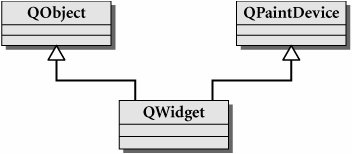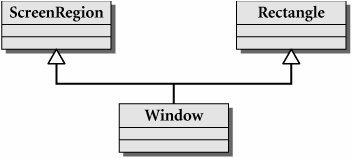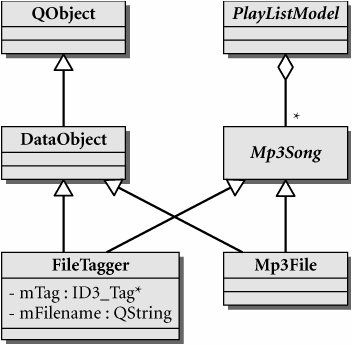tr() and Internationalization
Multiple Inheritance
Multiple inheritance is a form of inheritance in which a class inherits the structure and behavior of more than one base class.
Common uses of multiple inheritance:
- For crossing the functionality of very different classes with little overlap, such as in Figure 23.1.
Figure 23.1. QWidget's inheritance

- For implementing a common "pure interface" (class with only pure virtual functions) in a variety of different ways.[2]
[2] As we see in Section 23.3.2.
Multiple inheritance hierarchies are more complex and are harder to design, implement, and understand than single inheritance hierarchies. They can be used to solve some difficult design problems, but should not be used if a simpler approach (such as aggregation) is feasible. As with single inheritance, multiple inheritance defines a static relationship among classes. It cannot be changed at runtime.
23.3.1. Multiple Inheritance Syntax
The example in this section demonstrates multiple inheritance syntax and usage.
The two base classes shown in Figure 23.2, Rectangle and ScreenRegion, each have particular roles to play on the screen. One class is concerned with shape and location, while the other is concerned with color and visibility characteristics. A Window must be a Rectangle and a ScreenRegion. They are defined in Example 23.6.
Figure 23.2. Window and ScreenRegion

Example 23.6. src/multinheritance/window.h
#include "color.h"
#include "point.h"
class Rectangle {
public:
Rectangle( Const Point& ul, int length, int width);
Rectangle( const Rectangle& r) ;
void move (const Point &newpoint);
private:
Point m_UpperLeft;
int m_Length, m_Width;
};
class ScreenRegion {
public:
ScreenRegion( Color c=White);
ScreenRegion (const ScreenRegion& sr);
virtual color Fill( Color newColor) ;
void show();
void hide();
private:
Color m_Color;
// other members...
};
class Window: public Rectangle, public ScreenRegion {
public:
Window( const Point& ul, int len, int wid, Color c)
: Rectangle(ul, len, wid), ScreenRegion(c) {} <-- 1
Window( const Rectangle& rect, const ScreenRegion& sr)
: Rectangle(rect), ScreenRegion(sr) {} <-- 2
// Other useful member functions ...
};
|
There are some syntax items in the classHead of the derived class that deserve some attention.
- An access specifier, e.g., public or protected, must appear before each base class name if the derivation is not private.
- Default derivation is private.
- It is possible to have a mixture of public, protected, and private derivations.
- The comma (,) character separates the base classes.
- The order of base class initialization is the order in which the base classes are listed in the classHead.
Client code to put a Window on the screen is shown in Example 23.7.
Example 23.7. src/multinheritance/window.cpp
#include "window.h"
int main() {
Window w(Point(15,99), 50, 100, Color(22));
w.show(); <-- 1
w.move (Point(4,6)); <-- 2
return 0;
}
|
Member Initialization
Default initialization or assignment proceeds member by member in the order that data members are declared in the class definition: First, base classes; then, derived class members.
23.3.2. Multiple Inheritance with Abstract Interfaces
One situation where it is appropriate to use multiple inheritance is when more than one abstract interface is needed. Figure 23.3 shows a class diagram based on the MP3 Data Model assignment in Section 25.1. FileTagger inherits the DataObject/QObject for its signals and slots, as well as for its property() and setProperty() functions. FileTagger also needs the Mp3Song interface that defines all of the fields for which an ID3 tag should have getters/setters. Similarly, Mp3File needs both the DataObject and the Mp3Song interfaces, even though it is not connected to a physical MP3 file.
Figure 23.3. MP3 data model

Multiple inheritance can help reduce dependencies for client code. For example, a client function can have an Mp3Song parameter without needing id3lib or Qt in order to exploit the Mp3Song interface. Mp3Song, with only pure virtual functions, enforces the interface on all derived classes. Separating the interface from different implementations makes plugin-frameworks possible.
 |
In Figure 23.3, QObject is one of the base classes that is multiply inherited. One restriction Qt has is that QObject must only be inherited once by each class; further, the QObject-derived base must be listed first in the list of base classes. Breaking this rule will lead to strange errors from the code generated by moc, the MetaObject compiler. |
Point of Departure |
Part I: Introduction to C++ and Qt 4
C++ Introduction
- C++ Introduction
- Overview of C++
- A Brief History of C++
- Setup: Open-Source Platforms
- Setup: Win32
- C++ First Example
- Input and Output
- Identifiers, Types, and Literals
- C++ Simple Types
- C++ Standard Library Strings
- Streams
- The Keyword const
- Pointers and Memory Access
- const* and *const
- Reference Variables
- Points of Departure
- Review Questions
Classes
- Classes
- Structs
- Class Definitions
- Member Access Specifiers
- Encapsulation
- Introduction to UML
- Friends of a Class
- Constructors
- Subobjects
- Destructors
- The Keyword static
- Copy Constructors and Assignment Operators
- Conversions
- const Member Functions
- Review Questions
Introduction to Qt
- Introduction to Qt
- Example Project: Using QApplication and QLabel
- Makefile, qmake, and Project Files
- Getting Help Online
- Style Guidelines and Naming Conventions
- The Qt Core Module
- Streams and Dates
- Points of Departure
- Review Questions
Lists
Functions
- Functions
- Function Declarations
- Overloading Functions
- Optional Arguments
- Operator Overloading
- Parameter Passing by Value
- Parameter Passing by Reference
- References to const
- Function Return Values
- Returning References from Functions
- Overloading on const-ness
- Inline Functions
- Inlining versus Macro Expansion
- Review Questions
Inheritance and Polymorphism
- Inheritance and Polymorphism
- Simple Derivation
- Derivation with Polymorphism
- Derivation from an Abstract Base Class
- Inheritance Design
- Overloading, Hiding, and Overriding
- Constructors, Destructors, and Copy Assignment Operators
- Processing Command-Line Arguments
- Points of Departure
- Review Questions
Part II: Higher-Level Programming
Libraries
- Libraries
- Code Containers
- Reusing Other Libraries
- Organizing Libraries: Dependency Management
- Installing Libraries: A Lab Exercise
- Frameworks and Components
- Review Questions
Introduction to Design Patterns
QObject
- QObject
- QObjects Child Managment
- Composite Pattern: Parents and Children
- QApplication and the Event Loop
- Q_OBJECT and moc: A Checklist
- Values and Objects
- tr() and Internationalization
- Point of Departure
- Review Questions
Generics and Containers
- Generics and Containers
- Generics and Templates
- Containers
- Managed Containers, Composites, and Aggregates
- Implicitly Shared Classes
- Generics, Algorithms, and Operators
- Serializer Pattern
- Sorted Map Example
- Review Questions
Qt GUI Widgets
- Qt GUI Widgets
- Widget Categories
- QMainWindow and QSettings
- Dialogs
- Images and Resources
- Layout of Widgets
- QActions, QMenus, and QMenuBars
- QActions, QToolbars, and QActionGroups
- Regions and QDockWidgets
- Views of a QStringList
- Points of Departure
- Review Questions
Concurrency
- Concurrency
- QProcess and Process Control
- Threads and QThread
- Summary: QProcess and QThread
- Review Questions
Validation and Regular Expressions
- Validation and Regular Expressions
- Validators
- Regular Expressions
- Regular Expression Validation
- Review Questions
Parsing XML
Meta Objects, Properties, and Reflective Programming
- Meta Objects, Properties, and Reflective Programming
- Anti-patterns
- QMetaObject: The MetaObject Pattern
- Type Identification and qobject_cast
- Q_PROPERTY Macro: Describing QObject Properties
- QVariant Class: Accessing Properties
- DataObject: An Extension of QObject
- Property Containers: PropsMap
- Review Questions
More Design Patterns
- More Design Patterns
- Creational Patterns
- Serializer Pattern Revisited
- The Façade Pattern
- Points of Departure
- Review Questions
Models and Views
- Models and Views
- M-V-C: What about the Controller?
- Dynamic Form Models
- Qt 4 Models and Views
- Table Models
- Tree Models
- Review Questions
Qt SQL Classes
Part III: C++ Language Reference
Types and Expressions
- Types and Expressions
- Operators
- Evaluation of Logical Expressions
- Enumerations
- Signed and Unsigned Integral Types
- Standard Expression Conversions
- Explicit Conversions
- Safer Typecasting Using ANSI C++ Typecasts
- Run-Time Type Identification (RTTI)
- Member Selection Operators
- Point of Departure
- Review Questions
Scope and Storage Class
- Scope and Storage Class
- Declarations and Definitions
- Identifier Scope
- Storage Class
- Namespaces
- Review Questions
Statements and Control Structures
Memory Access
- Memory Access
- Pointer Pathology
- Further Pointer Pathology with Heap Memory
- Memory Access Summary
- Introduction to Arrays
- Pointer Arithmetic
- Arrays, Functions, and Return Values
- Different Kinds of Arrays
- Valid Pointer Operations
- What Happens If new Fails?
Chapter Summary
Inheritance in Detail
- Inheritance in Detail
- Virtual Pointers and Virtual Tables
- Polymorphism and virtual Destructors
- Multiple Inheritance
- Point of Departure
- public, protected, and private Derivation
- Review Questions
Miscellaneous Topics
Part IV: Programming Assignments
MP3 Jukebox Assignments
- MP3 Jukebox Assignments
- Data Model: Mp3File
- Visitor: Generating Playlists
- Preference: An Enumerated Type
- Reusing id3lib
- PlayListModel Serialization
- Testing Mp3File Related Classes
- Simple Queries and Filters
- Mp3PlayerView
- Models and Views: PlayList
- Source Selector
- Persistent Settings
- Edit Form View for FileTagger
- Points of Departure
Part V: Appendices
MP3 Jukebox Assignments
- MP3 Jukebox Assignments
- Appendix A. C++ Reserved Keywords
- Appendix B. Standard Headers
- Appendix C. The Development Environment
- Section C.1. The Preprocessor: For #including Files
- Section C.2. Understanding the Linker
- Section C.3. Debugging
- Section C.4. Qt Assistant and Designer
- Section C.5. Open-Source IDEs and Development Tools
Bibliography
MP3 Jukebox Assignments
EAN: 2147483647
Pages: 268
